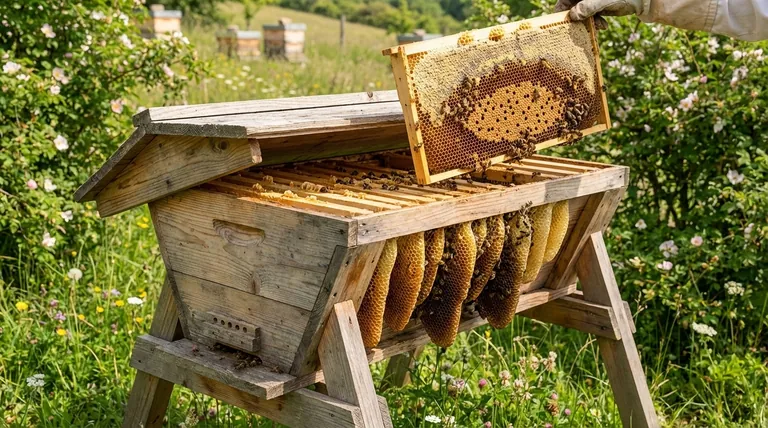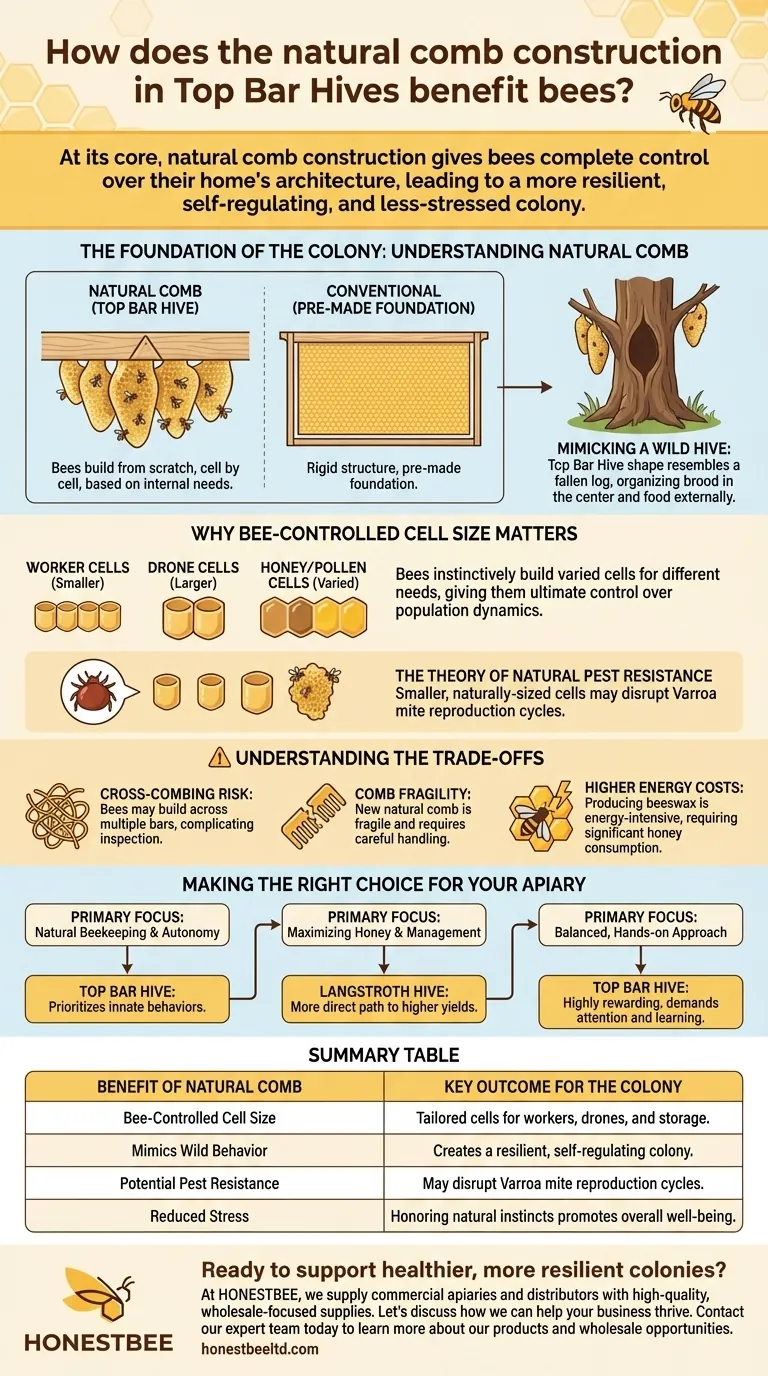At its core, natural comb construction in Top Bar Hives benefits bees by giving them complete control over the architecture of their home. This allows the colony to build comb with varied cell sizes tailored for raising brood, storing honey, and housing drones, directly mimicking the way they would behave in a natural, wild setting.
While conventional beekeeping often imposes a rigid structure with pre-made foundations, Top Bar Hives operate on a different principle. The central benefit is that honoring the bees' natural construction instincts can lead to a more resilient, self-regulating, and less-stressed colony.

The Foundation of the Colony: Understanding Natural Comb
A honey bee colony is a complex organism, and its comb is its skeleton, pantry, and nursery. How that comb is built has profound implications for the colony's health.
What Defines "Natural Comb"?
Natural comb is simply beeswax comb that bees build from scratch, without the guidance of a pre-imprinted sheet of "foundation."
In a Top Bar Hive, bees are given a simple wooden bar, often with a small wooden guide or wax strip. They use this as a starting point to draw down their comb, cell by cell, based entirely on the colony's internal needs.
How the Top Bar Guides Construction
The top bar itself serves as the only structural support. It provides an anchor from which the bees hang their finished comb.
This design encourages bees to build single, deep combs hanging vertically, which is how they naturally build in enclosed spaces like hollow trees. The beekeeper can then inspect the hive one bar at a time.
Mimicking a Wild Hive
The elongated, horizontal shape of a Top Bar Hive closely resembles a fallen log. This structure allows the colony to organize itself naturally.
Typically, the brood nest (where the queen lays eggs) is established in the center, with honey and pollen stored on the outer combs. This mirrors their wild behavior and allows the colony to expand or contract its nest with the seasons.
Why Bee-Controlled Cell Size Matters
The single most important benefit of foundationless, natural comb is the bees' ability to control the size of each individual cell. A uniform sheet of foundation removes this critical function from the colony.
Cells for Different Needs
A colony does not need one-size-fits-all cells. Bees instinctively build:
- Worker cells: Smaller cells for raising female worker bees.
- Drone cells: Larger cells for raising male drone bees.
- Honey and Pollen cells: Often varied in size and shape, built for efficient storage.
When bees control this process, they can build the exact number of drone or worker cells the colony requires at any given moment, giving them ultimate control over their population dynamics.
The Theory of Natural Pest Resistance
A key argument for natural comb centers on the Varroa mite, a devastating bee parasite. The theory suggests that bees on natural comb build smaller worker cells than the standardized size used on commercial foundation.
Because Varroa mites reproduce inside capped brood cells, some proponents believe that these smaller, naturally-sized cells can disrupt the mite's life cycle, making it harder for them to successfully reproduce. While this is a topic of debate, it remains a central pillar of the natural beekeeping philosophy.
Understanding the Trade-offs
While beneficial for the bees, managing natural comb presents unique challenges for the beekeeper that must be considered.
The Risk of Cross-Combing
Without a foundation to guide them, bees may build comb across multiple top bars instead of neatly within a single one. This "cross-combing" can "weld" the bars together, making inspection impossible without destroying the comb and damaging the colony.
Comb Fragility
New, natural comb is exceptionally fragile, especially in warm weather. It is supported only by its attachment to the top bar. Careless handling can easily cause a beautiful comb full of honey or brood to break and fall.
Higher Energy Costs for Bees
Producing beeswax is an energy-intensive process for bees. Building all of their comb from scratch requires a significant consumption of honey. This can result in a slower initial build-up and potentially lower honey surplus for the beekeeper in the first year.
Making the Right Choice for Your Apiary
Your beekeeping goals should dictate your hive choice. Natural comb construction is a powerful tool when aligned with the right philosophy.
- If your primary focus is natural beekeeping and bee autonomy: A Top Bar Hive is an excellent choice that prioritizes the colony's innate behaviors over all else.
- If your primary focus is maximizing honey production and ease of management: A traditional Langstroth hive with foundation may offer a more direct path to higher yields and simpler inspections.
- If your primary focus is finding a balanced, hands-on approach: A Top Bar Hive can be highly rewarding, but it demands careful attention and a willingness to learn the unique skills required for managing foundationless comb.
Ultimately, understanding how bees build and use their comb empowers you to make a more informed decision for the health and productivity of your colonies.
Summary Table:
| Benefit of Natural Comb | Key Outcome for the Colony |
|---|---|
| Bee-Controlled Cell Size | Tailored cells for workers, drones, and storage. |
| Mimics Wild Behavior | Creates a resilient, self-regulating colony. |
| Potential Pest Resistance | May disrupt Varroa mite reproduction cycles. |
| Reduced Stress | Honoring natural instincts promotes overall well-being. |
Ready to support healthier, more resilient colonies?
At HONESTBEE, we supply commercial apiaries and beekeeping equipment distributors with the high-quality, wholesale-focused supplies needed to succeed. Whether you're exploring Top Bar Hives or other natural beekeeping methods, our equipment is designed to support both bee health and your operational efficiency.
Let's discuss how we can help your business thrive. Contact our expert team today to learn more about our products and wholesale opportunities.
Visual Guide

Related Products
- Top Bar Beehive for Beekeeping Wholesales Kenya Top Bar Hive
- Long Langstroth Style Horizontal Top Bar Hive for Wholesale
- HONESTBEE Professional Long Handled Hive Tool with Precision Cutting Blade
- HONESTBEE Advanced Ergonomic Stainless Steel Hive Tool for Beekeeping
- HONESTBEE Professional Multi-Functional Hive Tool with Ergonomic Wood Handle
People Also Ask
- What are the key features of the Kenyan Top Bar Hive? A Guide to Simpler, Natural Beekeeping
- How is honey harvested from a top-bar hive? A Guide to Simple, Low-Equipment Processing
- What is the quickest method to harvest honey from a top bar hive? A Guide to the Simple 'Cut and Crush' Method
- What are the advantages of harvesting honey from a top bar hive? Low-Cost, Simple Harvesting for Beekeepers
- What are the labor requirements for a KTBH vs. Langstroth hive? A Guide for Apiary Efficiency



















